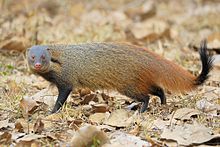
Back Urva Catalan Urva German Urva (genus) English خدنگهای آسیایی FA Urva (állatnem) Hungarian Urva Dutch Urva Polish Urva Russian Urva (род) Serbian உர்வா Tamil
| Urva | |
|---|---|

| |
| Urva vitticolla | |
| Klasifikasi ilmiah | |
| Kerajaan: | |
| Filum: | |
| Kelas: | |
| Ordo: | |
| Subordo: | |
| Famili: | |
| Subfamili: | |
| Genus: | Urva Hodgson, 1836
|
| Spesies tipe | |
| Urva urva Hodgson, 1836
| |
| Spesies | |
|
Lihat teks | |
Urva adalah genus Garangan (Herpestidae) yang terdiri dari Garangan yang berasal dari Asia. Spesies dalam genus ini sebelumnya diklasifikasikan dalam genus Herpestes, yang sekarang dianggap hanya terdiri dari Garangan Afrika. bukti filogenetik menunjukkan bahwa Garangan Asia membentuk kelompok monofiletik dan memiliki leluhur yang sama dari Asia. Urva membentuk klad dengan genus Xenogale dan Atilax, sedangkan Herpestes membentuk klad dengan semua spesies Garangan Afrika lainnya.[1][2]
Spesimen fosil Urva berupa gigi geraham atas, ditemukan di lembah Sungai Irrawaddy di Myanmar tengah dan diperkirakan berasal dari zaman Pliosen akhir.[3]
Nama ilmiah genus garangan ini diberi oleh Brian Houghton Hodgson sebagai nama spesifik Garangan pemakan kepiting pada tahun 1836,[4] dan sebagai nama generik pada tahun berikutnya.[5] Spesies anggotanya memiliki persebaran yang luas mulai dari Jazirah Arab hingga Pulau Jawa di Indonesia.[6] Musang India kecil (Urva auropunctata) telah diperkenalkan ke beberapa pulau pada akhir abad ke-19, di mana jenis garangan tersebut telah menjadi spesies invasif.[7][8]
- ^ Patou, M.; Mclenachan, P.A.; Morley, C.G.; Couloux, A.; Jennings, A.P.; Veron, G. (2009). "Molecular phylogeny of the Herpestidae (Mammalia, Carnivora) with a special emphasis on the Asian Herpestes". Molecular Phylogenetics and Evolution. 53 (1): 69–80. doi:10.1016/j.ympev.2009.05.038. PMID 19520178.
- ^ Zhou, Y.; Wang, S.-R.; Ma, J.-Z. (2017). "Comprehensive species set revealing the phylogeny and biogeography of Feliformia (Mammalia, Carnivora) based on mitochondrial DNA". PLoS ONE. 12 (3): e0174902. doi:10.1371/journal.pone.0174902
 . PMC 5373635
. PMC 5373635  . PMID 28358848.
. PMID 28358848.
- ^ Egi, N.; Nishioka, Y.; Tsubamoto, T.; Ogino, S.; Takai, M. (2011). "A mongoose remain (Mammalia: Carnivora) from the Upper Irrawaddy sediments, Myanmar and its significance in evolutionary history of Asian herpestids". Journal of Asian Earth Sciences. 42 (6): 1204–1209. doi:10.1016/j.jseaes.2011.07.003.
- ^ Hodgson, B. H. (1836). "Synoptical description of sundry new animals, enumerated in the Catalogue of Nepalese Mammals". Journal of the Asiatic Society of Bengal. 5 (52): 231–238.
- ^ Hodgson, B. H. (1837). "On a new genus of the Plantigrades". Journal of the Asiatic Society of Bengal. 6 (67): 560–565.
- ^ Veron, G.; Jennings, A.P. (2017). "Javan mongoose or small Indian mongoose – who is where?". Mammalian Biology. 87 (1): 62–70. doi:10.1016/j.mambio.2017.05.006
 .
.
- ^ Lowe, S.; Browne, M.; Boudjelas, S.; De Poorter, M. (2000). "Small Indian Mongoose (Herpestes javanicus (auropunctatus))" (PDF). 100 of the World’s Worst Invasive Alien Species. A selection from the Global Invasive Species Database. New Zealand: The Invasive Species Specialist Group, SSC IUCN, Hollands Printing Ltd. hlm. 10. Diarsipkan dari versi asli (PDF) tanggal 2018-12-22. Diakses tanggal 2021-09-02.
- ^ Louppe, V.; Lalis, A.; Abdelkrim, J.; Baron, J.; Bed’Hom, B.; Becker, A. A. M. J.; Catzeflis, F.; Lorvelec, O.; Zieger, U.; Veron, G. (2021). "Dispersal history of a globally introduced carnivore, the small Indian mongoose Urva auropunctata, with an emphasis on the Caribbean region". Biological Invasions. 23: 2573–2590. doi:10.1007/s10530-021-02523-6.